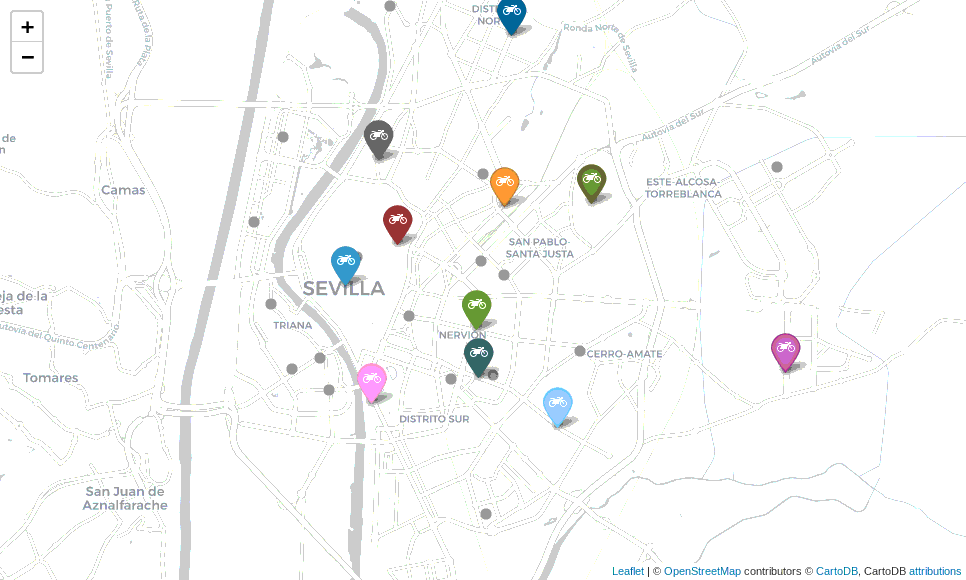SMES
.webp)
Food distribution in Mexico is a complex operation that faces multiple logistical challenges. From route management to on-time deliveries, companies in the sector must optimize every step to ensure freshness, quality and exceptional customer service. In this article, we will explore the main challenges faced by a food distribution company in the country and how technology, such as planning and optimizing routes of Routal, may be the key to improving efficiency.
1. Inefficient routes and high logistics costs
Food distribution companies, such as Proan and your brand San Juan eggs, operate with a high volume of daily deliveries to multiple destinations. Poor route planning can lead to longer delivery times, higher fuel consumption and high operating costs.
🔹 Solution: Route optimization software such as Routal allows us to calculate the most efficient routes considering factors such as traffic, road restrictions and delivery schedules, reducing costs and improving productivity.
2. Cold chain and transport conditions
For perishable products such as meat, dairy and eggs, maintaining the cold chain is essential. Any unexpected delay or deviation can compromise product quality and generate economic losses.
🔹 Solution: With Routal, and its partners can program optimized routes that minimize transit times and allow you to monitor the location of each vehicle and temperature control in real time, ensuring that food arrives in optimal condition and ensures the cold chain.
3. High customer requirements
Current customers, whether they are supermarkets, convenience stores or end consumers, expect fast and timely deliveries. Companies such as San Juan eggs distribute products nationally and must meet strict delivery times to maintain their reputation.
🔹 Solution: Routal makes it possible to improve punctuality by optimizing delivery times and providing customers with real-time information on the status of their orders.
4. Health regulations and regulations
The food sector in Mexico is subject to strict health and transportation regulations. Meeting these regulations without affecting operational efficiency is an ongoing challenge.
🔹 Solution: Smart planning with Routal helps to comply with delivery schedules and transportation regulations without affecting business profitability.
Transform your distribution with Routal
Technology is the best ally to overcome the challenges of food distribution in Mexico. Leading companies in the industry are adopting advanced route planning and optimization solutions to improve their efficiency and customer service.
🚀 Ready to optimize your operation? Find out how Routal can help you transform your distribution. Schedule a demo, or Try the tool yourself and take your logistics to the next level.

One of the main fears and brakes faced by SMEs in the face of digitalization is Integrate technology. The dichotomy between choosing an all-encompassing solution, or specific solutions for each problem. The benefit of the first option is that you're dealing with a provider, everything is talked about, and you shouldn't have too many problems. The problem is that it probably doesn't solve your processes in the best way and you have to make a lot of effort to adapt your business to the solution. The other option, small experts, usually provide a better solution for each process, but there is a difficulty in getting applications to talk to each other. This means that two companies collaborate, integrate and that can be a challenge.
More complex systems and technological solutions are increasingly required to optimize operations. The trend of one-fits-all (one solution for everything) is increasingly difficult to find and as companies grow they require more specific solutions, so integration projects are becoming more common, but above all, more necessary.
To give great examples, one of Inditex's great successes has been to have a single centralized stock between warehouses and stores, which allows us to have the status of each of the pieces of clothing in real time and achieve greater success in an omnichannel environment where the customer purchases online, is sent from several centers to be consolidated in the store and for the customer to pick up at the store buying an accessory that he found by chance. But something like that is not only available to large companies, SMEs also have a lot to say, and their scale makes them projects much easier, faster and cheaper to implement.

The benefits of integrating systems are direct improvements in productivity and in the quality of the service they provide, standardized and optimized operating processes, ease in internal processes, reduction of errors and also homogenization of data.
Why is it presented as a brake or challenge, or Why does it bring so many headaches for companies? Mainly because many companies do not have the experience, the resources to develop these projects internally or personnel with the knowledge to lead a project of this type. The solution, outsourcing these projects, and without good advice the project can be a big headache. For this reason, looking for a supplier who knows the business, the tools to be integrated and who has experience in similar projects are the key to success for an integration project to be successful, to develop quickly and on budget.
Unfortunately, sometimes digitalization brings high costs that companies don't want to face because of the doubt if there will really be a return on that investment. Digitalization with common sense, improving and streamlining processes undoubtedly generates great investment returns. For this reason, it is essential that companies have an orchestrator that understands the need of the business, the company's processes and those points that hold back the organization in order to optimize them through digitalization. The partner will actually implement that improvement, but it requires high-level coordination that will be the key to success.
Strategy, knowledge and execution.
Nowadays, execution is the easiest part of all. There are different types of integrations depending on the available systems and the objective. The most used are those of APIS (Application Programming Interface) where data is transmitted from one side to the other quickly and securely. It is the most used since it is simpler to perform and offers great performance. These are used to enter information to our platform. On the other hand, the most used to extract information is integration by Webhooks, in which the external system receives data when there is an event on the platform.
At Routal, we are constantly working to make integrations an opportunity to further streamline company processes, digitize and automate tasks that don't add value, and concentrate the work of employees on those points where a person actually provides the most value.
Quaker State Success Story: Integrating SAP
Quaker State is a leading company in the distribution of oils and lubricants for vehicles in Mexico. In 2020, they needed to standardize their merchandise delivery procedure and homogenize their operations so as not to rely on one or more people for the replacement of personnel. Faced with this situation, they implemented the Routal solution.
Thanks to the Planner intelligent route planner, they were able to unify processes into one, in addition to generating a single procedure that would be available to any worker regardless of their level of training.
Prior to the integration, the delivery routes were carried out manually, they spent hours daily in the planning process, there was little monitoring of the operation, and obtaining any report on performance metrics was an investment of tens of hours, which greatly limited the ability to make improvement decisions.
Once the integration of their SAP system with Routal was implemented, route planning began to be carried out in an automated manner and in minutes. The risk on the figure of the route planner and the dependence on that person was completely reduced. The creation of metric reports was also automated to improve the control and monitoring of their distribution processes, and most importantly: the data were reconciled and validated. Thus, the entire process was standardized and optimized.
”Routal Planner is essential to us. It saves us planning time and makes us more competitive against our competitors” Your Manager has your opinion.
Lácteas del Jarama Success Story: Integrating AS 400
Lácteas del Jarama It is one of the most important dairy companies in Spain, it was the first company to introduce mozzarella in our country and its history supports it as one of the main dairy companies in the food service sector.
The successful implementation of Routal was due to the successful integration of its ERP system, an IBM AS400, an extremely robust but difficult to integrate system. To be able to count on a partner like Nakima helped to be able to carry out the integration in just 3 weeks of work and thus reduce the start-up time to just over a month.
The internal leadership clearly identified the need to eliminate steps in the process that would focus logistics personnel on what really provides value: “Deliver quickly, with the lowest cost and offering the best possible service”.
The experience of working with professionals who are experts in this type of project means that companies can think further and want to improve other processes that seemed impossible to improve.
At Routal, we work to streamline integration processes through partners with a lot of experience in all types of technologies and businesses, achieving success so that projects are successful.
Try Routal for free for 10 days click here.


Sant Jordi is always a special day, books, roses, queues and people, lots of people. Everyone is out on the street, enjoying a magical day for both children and adults. It is the day of the year when the most books are sold, 7.5% of annual sales In the city of Barcelona.

This year will be special. We'll have to spend it at home, enjoying a good read, our recommendation for these days The Black Swan by Nassim Taleb. This year we will save ourselves the hassle of Las Ramblas and we will have to buy the roses online. Without a doubt, a special year.
We want to take advantage of this important date to see the success of initiatives that, in a normal year, would hardly have achieved such overwhelming success.
One of our customers Santjordiacasa.com is using Highway as a tool to optimize the distribution of roses on such a special date as Sant Jordi.

Thanks to the power of the Highway route planner, they have been able to grow in deliveries and reach customers that would have been impossible for them before.
Like them, hundreds of other customers are entering a world such as home delivery. A channel that had often been completely forgotten. Thanks, or unfortunately, COVID-19 has forced the launch of new marketing channels such as Ecommerce and its own distribution and home delivery.
We are seeing this in our traditional customers, distribution companies to the HORECA channel that are converting to home distributors overnight.
Pastry shops such as Cropics they were able to deliver all the Easter monkeys in record time and have the detail of leaving a monkey at my wife's grandmother's house 😁. These types of details make being able to help small businesses make you proud of the work you do and of seeing how you can help more people around you.

We are in a very difficult time for many companies and families. There is little help to get through this crisis and reaching those people we can help is always a challenge. I encourage you to share our story, the story of our users and customers, companies that are embarking on a new adventure, delivery. Without experience, without processes, but with a desire to fight and face the corona, you are not alone.
We won this together.

The distribution on demand is an industry that is growing at a very high speed. New companies appear every day, especially in the market for food, beverages and deliveries of perishable products. And the competition is wild. Efficiency is a key metric in the “I want it all and I want it now” era and the most critical part is what happens from when a new order is placed until it is delivered.
Today I want to focus on the problem of sending new orders, that is, how to decide which courier service the order should be assigned to when an order enters the system. This is because the dispatch today is not addressed systematically. Optimizing the dispatch system can minimize delivery time and improve customer satisfaction.
The operating paradigm of companies that deliver on demand can be divided into two different types:
- Operations based on a single warehouse are those operations focused on a single tank. This warehouse has several dealers and the programming is done once to obtain an order list; usually grouping orders by area. Amazon Prime is a good example of this paradigm.
- Operations based on multiple warehouses are those operations that rely on choosing the order in one of the multiple warehouses and delivering it to a customer. In this case, the delivery people are scattered around the city, and once a new order arrives, it is assigned through a shipping process to one of the multiple delivery people. Companies such as Uber, Just Eat, Delivero, etc. operate this way.
The problem of dispatching is solved more or less satisfactorily in the first scenario thanks to the possibility of linking together a list of deliveries and considering it as a Traveling Seller Problem (Traveling Salesman Problem) with some pre-clustering restrictions (OK, I know that TSP is an expensive problem, but... come on, it's about Amazon).
On the contrary, in the second scenario, it is not so clear that the problem is being optimally addressed. How can a new incoming order be added to a running scenario? There are tons of variables to consider:
- Can the courier make multiple collections before starting to deliver?
- Can an already assigned order be reassigned to another courier service?
- Do all orders have the same priority? (for example, all orders must be delivered no later than 30 minutes after placing them)
Do orders need to be delivered by a particular vehicle? - ...

Modeling this scenario can be quite challenging, and that's why SmartMonkey has been working on this problem for a while. We call our solution Online Programming Optimization Model (OSOM) (Yes, branding isn't one of our strengths 😅, but phonetically it sounds like “incredible” and that's pretty fun). OSOM can model business restrictions and find a feasible solution to the dispatching problem.
In the simulation below, we have modeled a world where:
- A courier service can be assigned multiple pickups and deliveries at the same time
- and the first next service of each messaging service is fixed and cannot be reassigned in subsequent iterations.
The visualization contains twenty iterations of the world divided into two steps:
1. New incoming services are marked in gray.
2. Services are dynamically assigned to deliverers to optimize overall delivery time.






.png)


